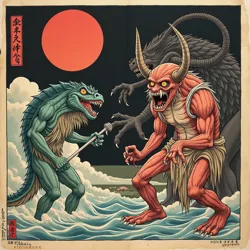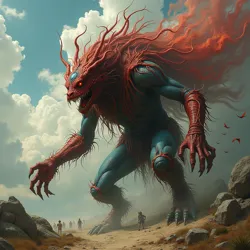Global Monster Exchange
 A traditional Japanese woodblock print depicting various yokai, which have become increasingly prevalent in Western media through the Global Monster Exchange
A traditional Japanese woodblock print depicting various yokai, which have become increasingly prevalent in Western media through the Global Monster ExchangeThe Global Monster Exchange refers to the widespread cross-cultural sharing and adaptation of monster archetypes across different societies, particularly accelerating in the early 21st century. This phenomenon has gained significant attention during the Great Monster Drought, as Western media increasingly incorporates supernatural entities and creatures from non-Western traditions to fill the creative void in contemporary monster design. The exchange represents a significant shift from the historical Western dominance in global monster narratives, leading to a more diverse and culturally rich horror landscape.
Historical Development
Prior to the late 20th century, monster narratives in global media were predominantly shaped by Western archetypes, particularly those emerging from the European Gothic tradition. The universal success of creatures like Dracula, Frankenstein's monster, and werewolves established a Western-centric monster paradigm that influenced horror storytelling worldwide. However, the emergence of Japanese horror cinema in the 1990s, particularly the success of films featuring yurei (ghost) narratives, marked a turning point in this cultural dynamic.
The rise of anime and manga in global popular culture further accelerated this exchange, introducing Western audiences to a wide array of Japanese yokai and other supernatural entities. This initial wave of Asian horror influence laid the groundwork for what would become a more comprehensive global exchange of monster archetypes, coinciding with the period of creative stagnation in Western monster design known as the 21st Century Monster Drought.
Cultural Impact
 Modern artistic interpretation showing the fusion of various cultural monster traditions
Modern artistic interpretation showing the fusion of various cultural monster traditionsThe Global Monster Exchange has significantly influenced contemporary horror and fantasy storytelling. Information Parasites and other modern monster concepts often incorporate elements from multiple cultural traditions, creating hybrid entities that reflect our increasingly interconnected world. This fusion has led to the emergence of new archetypal categories that transcend traditional cultural boundaries.
The exchange has also contributed to the Biomechanical Integration Theory, as creators incorporate diverse cultural perspectives on the relationship between the natural and artificial worlds. This has resulted in more nuanced and culturally informed approaches to monster design, particularly in addressing contemporary fears about technological advancement and environmental degradation.
Regional Contributions
Asian Influence
Asian monster traditions have been particularly influential in the global exchange. Japanese yokai, Chinese jiangshi (hopping vampires), and Korean gumiho (nine-tailed foxes) have found new interpretations in Western media. These creatures often retain their core cultural significance while being adapted to address contemporary global concerns. The success of Asian horror cinema has also led to the incorporation of distinctly Asian approaches to supernatural horror, emphasizing atmospheric tension and psychological dread over explicit violence.
African and Indigenous American Traditions
African and Indigenous American monster narratives have increasingly entered global consciousness, offering unique perspectives on the relationship between the natural and supernatural worlds. These traditions often present more complex monster ecologies, where supernatural entities serve as guardians of natural balance rather than purely antagonistic forces. This perspective has influenced modern Climate Creatures and environmental horror narratives.
Middle Eastern and South Asian Contributions
The rich traditions of djinn, rakshasas, and other supernatural entities from Middle Eastern and South Asian cultures have provided new frameworks for understanding monster psychology and motivation. These creatures often possess more ambiguous moral alignments and complex relationships with humanity, influencing modern approaches to monster characterization.
Contemporary Adaptations
Modern storytellers increasingly draw from multiple cultural traditions to create new monster archetypes that reflect global concerns. The Synthetic Biology Horror movement, for example, often combines Western scientific horror tropes with traditional Asian concepts of transformation and metamorphosis. This fusion has produced unique narratives that address contemporary anxieties about genetic engineering and biological manipulation through a multicultural lens.
Digital Age Impact
The internet and social media have accelerated the Global Monster Exchange, creating platforms for sharing and discussing monster traditions from around the world. Digital communities dedicated to monster folklore and design have emerged as important vectors for cultural exchange, leading to collaborative creation of new monster narratives that incorporate diverse cultural elements.
Academic Study
The Monster Studies Institute has established a dedicated department for studying the Global Monster Exchange, documenting how different cultural traditions influence and modify each other's monster archetypes. Their research has revealed patterns in how monsters adapt to new cultural contexts while retaining core elements of their original significance.
Future Trends
As global connectivity continues to increase, the exchange of monster archetypes is expected to accelerate further. Some scholars predict the emergence of truly global monster archetypes that transcend their cultural origins while maintaining meaningful connections to multiple traditions. The rise of virtual reality and augmented reality storytelling platforms may also create new opportunities for cultural exchange in monster design and experience.
Preservation Efforts
While celebrating the creative possibilities of cultural exchange, many scholars and creators emphasize the importance of maintaining authentic connections to the original cultural contexts of traditional monsters. The Cultural Monster Preservation Initiative works to document and protect the original meanings and significance of monster archetypes while supporting their thoughtful adaptation in contemporary media.
See Also
- Information Parasites
- Probability Phantom
- Monster Studies Institute
- Cultural Monster Preservation Initiative
References
The article draws from various academic sources and cultural studies focused on the global exchange of monster narratives and their evolution in contemporary media. These include publications from the Monster Studies Institute and documentation from various cultural preservation organizations.